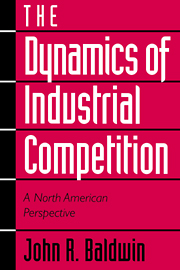Book contents
- Frontmatter
- Contents
- preface
- Acknowledgements
- 1 The dynamics of competition
- 2 Greenfield entry and closedown exit
- 3 Entry, exit, and the merger process
- 4 The rise and fall of incumbents
- 5 Patterns of large- and small-firm mobility
- 6 Plant turnover in Canada and the United States
- 7 Measures of market structure and the intensity of competition
- 8 The relationship between mobility and concentration
- 9 Turnover and productivity growth
- 10 Merger success
- 11 Turnover in domestic and foreign enterprises
- 12 Industry efficiency and firm turnover in the Canadian manufacturing sector
- 13 Firm turnover and profitability
- 14 Modelling entry
- 15 Conclusion
- Appendix A Measuring firm turnover – methodology
- Appendix B Definition of concentration and mobility measures
- Notes
- References
- Author index
- Subject index
10 - Merger success
Published online by Cambridge University Press: 30 March 2010
- Frontmatter
- Contents
- preface
- Acknowledgements
- 1 The dynamics of competition
- 2 Greenfield entry and closedown exit
- 3 Entry, exit, and the merger process
- 4 The rise and fall of incumbents
- 5 Patterns of large- and small-firm mobility
- 6 Plant turnover in Canada and the United States
- 7 Measures of market structure and the intensity of competition
- 8 The relationship between mobility and concentration
- 9 Turnover and productivity growth
- 10 Merger success
- 11 Turnover in domestic and foreign enterprises
- 12 Industry efficiency and firm turnover in the Canadian manufacturing sector
- 13 Firm turnover and profitability
- 14 Modelling entry
- 15 Conclusion
- Appendix A Measuring firm turnover – methodology
- Appendix B Definition of concentration and mobility measures
- Notes
- References
- Author index
- Subject index
Summary
Introduction
Whether the turnover that results from mergers produces real gains is a controversial topic. Mergers are seen to fulfil a number of roles. The most favourable view of their role comes from the theory of corporate control, which holds that mergers and related transactions shift control of business assets into the hands of more efficient managers. According to this theory, gains in performance can be traced to various sources. Changes in control can reduce inputs or salary and wage costs. They can shift resources to better managers and thus produce more value to the firm.
Although the theory is clear on the potential value of the market for corporate control, sceptics in the United States and Britain suggest that there are reasons, both theoretical and empirical, to doubt its efficacy. Markets for corporate control only work when there are sufficient arbitrageurs to take advantage of management lapses and when control can be wrestled from the managers. Some doubters suggest that there are not enough arbitrageurs. Others argue that managers in widely held firms are relatively immune to take-over. Still others claim to have detected serious defects in the performance of the take-over market, thereby suggesting that the market for corporate control works rather ineffectively.
Evidence on the negative effect of large diversifying mergers in the United States was first produced by studies of the popular conglomerate merger movement of the 1960s. Studies using data from the 1960s and 1970s indicate that acquisitions by large firms failed to raise the profitability of the acquired business units. Indeed, Ravenscraft and Scherer (1987) find that profitability was reduced as a result of mergers. Mueller (1985) finds that the market shares of business units transferred through larger mergers over the period 1950–72 fell substantially.
- Type
- Chapter
- Information
- The Dynamics of Industrial CompetitionA North American Perspective, pp. 239 - 262Publisher: Cambridge University PressPrint publication year: 1995



